| Building Unity Reading with Questions |
|---|
| www.studenthandouts.com ↣ American History ↣ American History Readings with Questions |
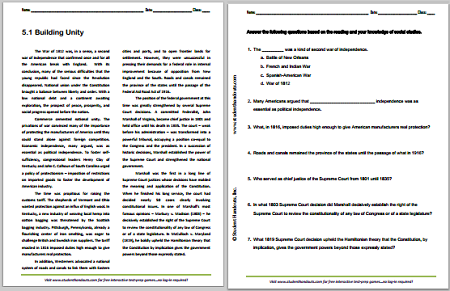 The War of 1812 was, in a sense, a second war of independence that confirmed once and for all the American break with England. With its conclusion, many of the serious difficulties that the young republic had faced since the Revolution disappeared. National union under the Constitution brought a balance between liberty and order. With a low national debt and a continent awaiting exploration, the prospect of peace, prosperity, and social progress opened before the nation.
The War of 1812 was, in a sense, a second war of independence that confirmed once and for all the American break with England. With its conclusion, many of the serious difficulties that the young republic had faced since the Revolution disappeared. National union under the Constitution brought a balance between liberty and order. With a low national debt and a continent awaiting exploration, the prospect of peace, prosperity, and social progress opened before the nation.Commerce cemented national unity. The privations of war convinced many of the importance of protecting the manufacturers of America until they could stand alone against foreign competition. Economic independence, many argued, was as essential as political independence. To foster self-sufficiency, congressional leaders Henry Clay of Kentucky and John C. Calhoun of South Carolina urged a policy of protectionism—imposition of restrictions on imported goods to foster the development of American industry. The time was propitious for raising the customs tariff. The shepherds of Vermont and Ohio wanted protection against an influx of English wool. In Kentucky, a new industry of weaving local hemp into cotton bagging was threatened by the Scottish bagging industry. Pittsburgh, Pennsylvania, already a flourishing center of iron smelting, was eager to challenge British and Swedish iron suppliers. The tariff enacted in 1816 imposed duties high enough to give manufacturers real protection. In addition, Westerners advocated a national system of roads and canals to link them with Eastern cities and ports, and to open frontier lands for settlement. However, they were unsuccessful in pressing their demands for a federal role in internal improvement because of opposition from New England and the South. Roads and canals remained the province of the states until the passage of the Federal Aid Road Act of 1916. The position of the federal government at this time was greatly strengthened by several Supreme Court decisions. A committed Federalist, John Marshall of Virginia, became chief justice in 1801 and held office until his death in 1835. The court—weak before his administration—was transformed into a powerful tribunal, occupying a position co-equal to the Congress and the president. In a succession of historic decisions, Marshall established the power of the Supreme Court and strengthened the national government. Marshall was the first in a long line of Supreme Court justices whose decisions have molded the meaning and application of the Constitution. When he finished his long service, the court had decided nearly 50 cases clearly involving constitutional issues. In one of Marshall's most famous opinions—Marbury v. Madison (1803)—he decisively established the right of the Supreme Court to review the constitutionality of any law of Congress or of a state legislature. In McCulloch v. Maryland (1819), he boldly upheld the Hamiltonian theory that the Constitution by implication gives the government powers beyond those expressly stated. Questions with answers in bold: 1. The __________ was a kind of second war of independence. a. Battle of New Orleans b. French and Indian War c. Spanish-American War d. War of 1812 2. Many Americans argued that economic independence was as essential as political independence. 3. What, in 1816, imposed duties high enough to give American manufacturers real protection? customs tariff 4. Roads and canals remained the province of the states until the passage of what in 1916? Federal Air Road Act 5. Who served as chief justice of the Supreme Court from 1801 until 1835? John Marshall 6. In what 1803 Supreme Court decision did Marshall decisively establish the right of the Supreme Court to review the constitutionality of any law of Congress or of a state legislature? Marbury v. Madison 7. What 1819 Supreme Court decision upheld the Hamiltonian theory that the Constitution, by implication, gives the government powers beyond those expressly stated? McCulloch v. Maryland Click here to print. |
 | 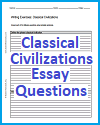 | 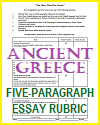 | 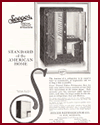 | 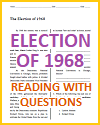 |
| www.studenthandouts.com ↣ American History ↣ American History Readings with Questions |








